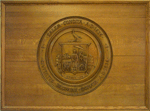Salem Athenaeum: Difference between revisions
From Salem Links and Lore
No edit summary |
No edit summary |
||
| Line 1: | Line 1: | ||
*This private library founded in 1810, began by the merging of two local libraries, the Social Library, founded in 1760, and the Philosophical Library, founded in 1781. For the first four decades, the Athenaeum had | *This private library founded in 1810, began by the merging of two local libraries, the Social Library, founded in 1760, and the Philosophical Library, founded in 1781. For the first four decades, the Athenaeum had no permanent home and occupied quarters at four different locations in Salem. In the 1850's a bequest by Carolin Plummer enable the group to build at 134 Essex St, which was its home until the early 1900's. | ||
no permanent home and occupied quarters at four different locations in Salem. In the 1850's a bequest by Carolin Plummer enable the group to build at 134 Essex St, which was its home until the early 1900's. | |||
*The Athenaeum sold the building to the Essex Institute in 1905 and built the current building in 1906. Dedicated in 1907, this red brick structure is modeled in "Homewood" the house in Maryland that Charles Carroll of Carrollton, a signer of the Declaration of Independence, built for his son. | *The Athenaeum sold the building to the Essex Institute in 1905 and built the current building in 1906. Dedicated in 1907, this red brick structure is modeled in "Homewood" the house in Maryland that Charles Carroll of Carrollton, a signer of the Declaration of Independence, built for his son. | ||
Revision as of 10:17, 11 July 2008
- This private library founded in 1810, began by the merging of two local libraries, the Social Library, founded in 1760, and the Philosophical Library, founded in 1781. For the first four decades, the Athenaeum had no permanent home and occupied quarters at four different locations in Salem. In the 1850's a bequest by Carolin Plummer enable the group to build at 134 Essex St, which was its home until the early 1900's.
- The Athenaeum sold the building to the Essex Institute in 1905 and built the current building in 1906. Dedicated in 1907, this red brick structure is modeled in "Homewood" the house in Maryland that Charles Carroll of Carrollton, a signer of the Declaration of Independence, built for his son.
